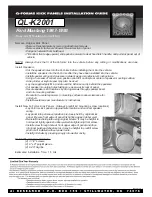
Series R y ST. Manual de Usuario /
R and ST Series. User's Manual
46
2. CONNECTIONS
2.1 Wiring
R and ST series enclosures utilise two NL4 (four pin) or NL8
(eight pin) Neutrik Speakon connectors. These connectors are
specific for speaker use and allow a safe and professional
connection. Models ST-112, ST-215, ST-18 and ST-218 use
NL8, the rest use NL4. For plugging into an enclosure, insert
the male connector into any of the inputs and rotate it
clockwise. It will then lock into place and be ready for use.
The drawing illustrates the terminal arrangement detail:
The enclosures provide two
paralleled connectors. This
allows for easy loop through
from one speaker to the next.
Unused connector pins are
also paralleled. Both
connectors can be used as
either inputs or outputs.
To ensure quality sound and
minimum power loss, the
speaker cable needs to have
a large enough cross section
depending on the cable
length, number of speakers
per channel and speaker
impedance. The total
impedance for a number of
speakers in parallel is equal
to the impedance of one
divided by the number of
speakers. For instance, two
R-112 in parallel total 4 ohms
(8 ohms divided by 2 boxes
equal 4). It is particularly
important to use a large
enough gauge with those
speakers that carry deep
bass, such as ST-18/218,
SUB-18R/218 o R-215.
The tables show the minimum size for different runs of cable
and four or eight ohms connected per channel:
- Use the eight ohm table when connecting a single eight
ohm speaker per channel. For instance, one R-115 in each
channel of a stereo amplifier or the mid frequency band of an
ST-112,
- Use the four ohm table when connecting two eight ohm
speakers to an amplifier channel. For instance, two R-115
units in parallel. Also for one four ohm speaker per channel,
such as for one ST-218 per channel.
When connecting more than one speaker to an amplifier
channel there are two wiring options. The first is to run cable
from the amplifier's output terminals to each speaker. The
second is to connect the closest speaker to the amplifier and
then connect the two speakers together with a loop through
cable that has a Speakon (NL8 or NL4 according to the model)
connector on both ends. We'll be paralleling speakers in both
cases. The latter is the most common and practical option, the
former providing a higher damping factor.
Never use a total impedance load that is lower than the lowest
impedance that an amplifier will take. Virtually all professional
amplifiers will accept loads down to four ohms safely in stereo
mode. Many are rated for two ohm loads but often will run
into overheating protection when used this way, particularly in
high ambient temperature and high output power applications.
Never connect more speakers to an amplifier's channel than it
will take, i.e. do not load a channel with a total impedance that
is lower than the minimum load specified by the manufacturer.
Avoid series or series-parallel wiring schemes for ST and R
series products, since they degrade sound quality and thus we
do not recommend them for applications other than
background music, paging, or surround sound.
8 ohm per amplifier channel
Cable length
Minimum cable thickness
metres
feet
mm²
Gauge no. (AWG)
2,5 8
0,3
22
5 16
0,5
22
7,5 25
0,8
18
10 33
1,31
16
15 50
2,1
14
20 66
3,3
12
50 164
5,3
10
75 250
8,35
8
100 328
13,3
6
200 656
20,8
4
400 1312
33,3
2
4 ohm per amplifier channel
Cable length
Minimum cable thickness
metres
feet
mm²
Gauge no. (AWG)
2,5 8
0,8
18
5 16
1,31
16
7,5 25
2,1
14
10 33
3,3
12
15 50
5,3
10
20 66
5,3
10
50 164
13,3
6
75 250
20,8
4
100 328
33,3
2
200 656
52,9
0
400 1312
80,2
000
www.audiovias.com









































